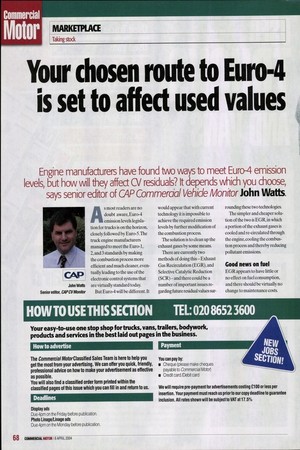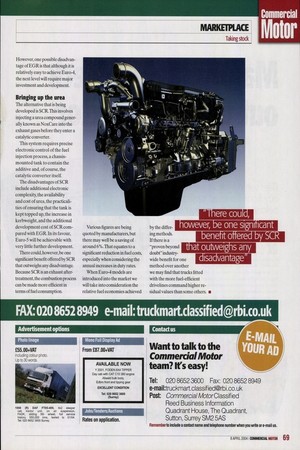Your chosen route to Euro-4 is set to affed used values
Page 68

Page 69

If you've noticed an error in this article please click here to report it so we can fix it.
Engine manufacturers have found two ways to meet Euro-4 emission levels, but how will they affect CV residuals? It depends which you choose,
says senior editor of CAP Commercial Vehicle Monitor John Watts.
As most readers are no doubt aware, Euro-4 emission levels legislation for trucks is on the horizon, closely followed by Euro-5.The truck engine manufacturers managed to meet the Euro-1, 2, and 3 standards by making the combustion process more efficient and much cleaner, eventually leading to the use of the electronic control systems that are virtually standard today. But Euro-4 will be different. It
would appear that with current technology it is impossible to achieve the required emission levels by further modification of the combustion process.
The solution is to clean up the exhaust gases by some means. There are currently two methods of doing this—Exhaust Gas Recirculation (EGR), and Selective Catalytic Reduction (SCR) — and there could be a number of important issues regarding future residual values sur
rounding these two technologies.
The simpler and cheaper solution of the two is EGR, in which a portion of the exhaust gases is cooled and re-circulated through the engine, cooling the combustion process and thereby reducing pollutant emissions. Good news on fuel
EGR appears to have little or no effect on fuel consumption, and there should be virtually no change to maintenance costs.
However, one possible disadvantage of EGR is that although it is relatively easy to achieve Euro-4, the next level will require major investment and development. Bringing up the urea
The alternative that is being developed is SCR.This involves injecting a urea compound generally known as NoxCare into the exhaust gases before they enter a catalytic converter.
This system requires precise electronic control of the fuel injection process, a chassismounted tank to contain the additive and, of course, the catalytic converter itself.
The disadvantages of SCR include additional electronic complexity, the availability and cost of urea, the practicalities of ensuring that the tank is kept topped up, the increase in kerbweight, and the additional development cost of SCR compared with EGR. In its favour, Euro-5 will be achievable with very little further development.
There could, however, be one significant benefit offered by SCR that outweighs any disadvantage. Because SCR is an exhaust aftertreatment, the combustion process can be made more efficient in terms of fuel consumption.
Various figures are being quoted by manufacturers, but there may well be a saving of around 6%.That equates to a significant reduction in fuel costs, especially when considering the annual increases in duty rates. When Euro-4 models are introduced into the market we will take into consideration the relative fuel economies achieved
by the differing methods. If there is a "proven beyond doubt" industry wide benefit for one method over another we may find that trucks fitted with the more fuel-efficient drivelines command higher residual values than some others. •






































































































